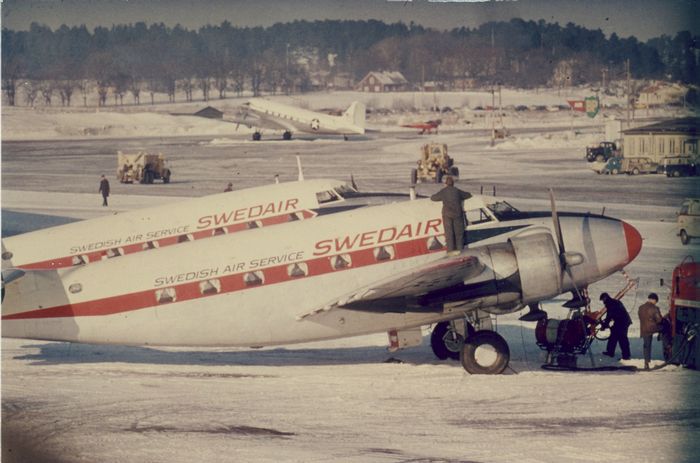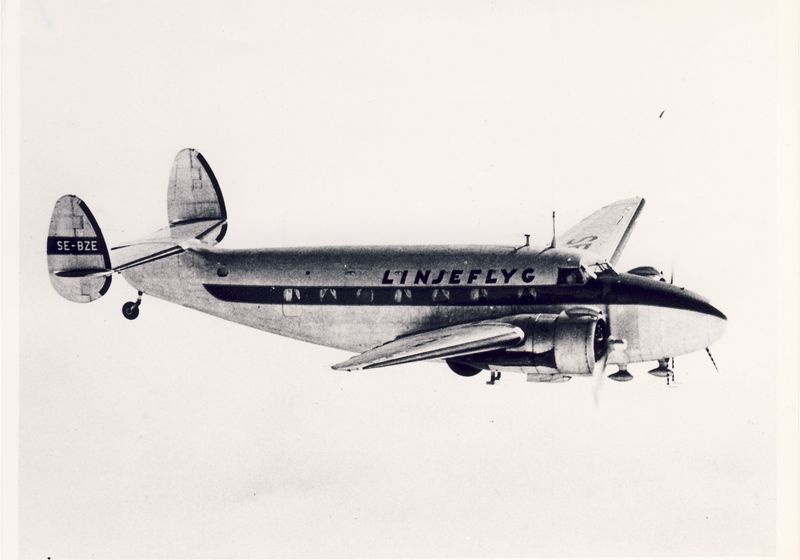Fra min bok "The Stockholm Run". I stor grad basert på svensk og britisk havarirapport, samt andre kilder.
On 2 May 1945, Lodestar G-AGLI lost its way in heavy fog on its flight to Bromma on the northern route. The aircraft was piloted by Lt Aage Schaanning, with co-pilot Bergfinn Aaslid and R/O 2nd Lt Kåre Norman Klausen. They were carrying six passengers and 26 bags of Norwegian diplomatic mail. The aircraft was heading towards the radio signals from the SIM beacon at Yttermalung. The signals had however guided them off course, too far north. For a long time after the estimated time for reaching Yttermalung, the radio signals still guided them eastwards. R/O Klausen thus signalled a QDM (Q-code request for a magnetic heading from the aircraft’s position to a station) to Bromma Aiport. He eventually got a reply “QDM NIL” meaning that they could not give a course. He misinterpreted this as “QDM 0”, meaning zero degrees. The pilot thus changed course, heading straight north. At this time, they had come out of the clouds and could see the coastline. Since they thought they were south of Stockholm they followed the coast northwards. The coastline did not match the map and, when the coastline turned southwards, they finally understood that they were over Finland, and they turned around.
At 05:26 in the morning (Swedish time), after 8h 20min flying, they were out of fuel and the pilot was forced to make an emergency landing. Failing to find a suitable landing ground, the pilot gently took the aircraft down on water at Sikeåfjärden in Västerbotten, off Sikeå in north-eastern Sweden, 50 km (30 miles) north east of Umeå. The aircraft came to rest 200-300 m from the shore where it floated for ten minutes before it sank to a depth of six meters. The crew managed to push out two rubber boats, which could take three persons each. The other three were taken ashore by a fishing boat. One of the passengers in the dingy had fallen in the water, and was staying afloat until being rescued by the crew of the fishing vessel.
The crew and passengers were taken to a nearby house to dry their clothes and were given a meal. They were interrogated by the local police but, since all crew and passengers had British passports and time-limited residence permits for Sweden, there was no reason for internment. They were brought to Umeå the same afternoon and departed by train to Stockholm at 18:04. The engines were later recovered to be used as spares and instructional parts at Bromma.
Other BOAC and AATS aircraft were also guided off course that night, though not with the same consequences as Schaanning’s aircraft. Lt Giørtz in Lodestar G-AGII landed at Torslanda with empty fuel tanks, while an AATS Liberator had returned to England after circling for some time south of Stockholm without finding its way to the airport. Also, Maj Thorsager in Lodestar G-AGLG was far off course before he finally received the radio signals from Bromma. It was concluded that the Germans had set up a powerful radio beacon sending at the same frequency as SIM, but with a much stronger signal.
Nils


